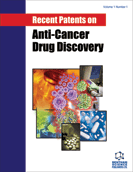Abstract
Increasing evidence suggests that four-stranded tetraplex structures spontaneously form under physiological conditions and these alternate DNA structures are likely to form in vivo. Alternate G-quadruplex DNA structures that may form in regulatory elements of oncogenes or G-rich telomere sequences are potential targets for cancer therapy since these sequence-specific structures are proposed to affect gene expression and telomerase activation, respectively. Small molecule compounds that specifically bind tetraplexes may be used to regulate cell cycle progression by modulating promotor activation or disrupting telomere maintenance, important processes of cellular transformation. In this review, we summarize the current research developments and associated patents that bear relevance to understanding the mechanism and clinical application of tetraplex binding molecules as anti-cancer agents.
Keywords: Tetraplex, G4, quadruplex, anti-cancer drug, chemotherapy, telomere, oncogene, helicase, RecQ, transcription
Recent Patents on Anti-Cancer Drug Discovery
Title: Tetraplex Binding Molecules as Anti-Cancer Agents
Volume: 1 Issue: 2
Author(s): Kevin M. Doherty, Sudha Sharma, Rigu Gupta and Robert M. Brosh Jr.
Affiliation:
Keywords: Tetraplex, G4, quadruplex, anti-cancer drug, chemotherapy, telomere, oncogene, helicase, RecQ, transcription
Abstract: Increasing evidence suggests that four-stranded tetraplex structures spontaneously form under physiological conditions and these alternate DNA structures are likely to form in vivo. Alternate G-quadruplex DNA structures that may form in regulatory elements of oncogenes or G-rich telomere sequences are potential targets for cancer therapy since these sequence-specific structures are proposed to affect gene expression and telomerase activation, respectively. Small molecule compounds that specifically bind tetraplexes may be used to regulate cell cycle progression by modulating promotor activation or disrupting telomere maintenance, important processes of cellular transformation. In this review, we summarize the current research developments and associated patents that bear relevance to understanding the mechanism and clinical application of tetraplex binding molecules as anti-cancer agents.
Export Options
About this article
Cite this article as:
Doherty M. Kevin, Sharma Sudha, Gupta Rigu and Brosh Jr. M. Robert, Tetraplex Binding Molecules as Anti-Cancer Agents, Recent Patents on Anti-Cancer Drug Discovery 2006; 1 (2) . https://dx.doi.org/10.2174/157489206777442232
| DOI https://dx.doi.org/10.2174/157489206777442232 |
Print ISSN 1574-8928 |
| Publisher Name Bentham Science Publisher |
Online ISSN 2212-3970 |
 3
3
- Author Guidelines
- Bentham Author Support Services (BASS)
- Graphical Abstracts
- Fabricating and Stating False Information
- Research Misconduct
- Post Publication Discussions and Corrections
- Publishing Ethics and Rectitude
- Increase Visibility of Your Article
- Archiving Policies
- Peer Review Workflow
- Order Your Article Before Print
- Promote Your Article
- Manuscript Transfer Facility
- Editorial Policies
- Allegations from Whistleblowers
Related Articles
-
Anticancer Perspectives on the Fungal-Derived Polyphenolic Hispolon
Anti-Cancer Agents in Medicinal Chemistry The Link Between Conventional and Novel Anti-Cancer Therapeutics with Thrombotic Microangiopathy
Drug Metabolism Letters Molecular Mechanism of Anti-tumor Effect by Triptolide in Hematological Malignancies
Current Signal Transduction Therapy An Overview of Targeted Alpha Therapy with <sup>225</sup>Actinium and <sup>213</sup>Bismuth
Current Radiopharmaceuticals Efficacy of Pegylated Lyposomal Anthracyclines and of Intra-Arterial Carboplatin and Doxorubicin Combined with Local Hyperthermia in a Case of Malignant Endovascular Papillary Angioendothelioma
Current Drug Delivery Natural Compounds in Anti-Leukaemic Therapy: A Review
Mini-Reviews in Medicinal Chemistry Radiolabelled Quinoline Derivaties for the PET Imaging of Peripheral Benzodiazepine Receptor
Current Medical Imaging Flavaglines: Their Discovery from Plants Used in Traditional Chinese Medicine, Synthesis, and Drug Development Against Cancer and Immune Disorders
Current Chinese Chemistry Implications of PEGylation of Carbon Nanotubes for Central Nervous System Bioavailability
CNS & Neurological Disorders - Drug Targets Biological Activities of Yarrow Species (Achillea spp.)
Current Pharmaceutical Design Beyond PD-1/PD-L1 Axis Blockade: New Combination Strategies in Metastatic Melanoma Treatment
Current Cancer Therapy Reviews Molecular Imaging in Optical Coherence Tomography
Current Molecular Imaging (Discontinued) Cell Cycle and Cancer: The G1 Restriction Point and the G1 / S Transition
Current Genomics The Emerging Role of TRP Channels in Mechanisms of Temperature and Pain Sensation
Current Neuropharmacology Synthesis, Biological and Computational Evaluation of Novel 2,3-dihydro-2-aryl-4-(4- isobutylphenyl)-1,5-benzothiazepine Derivatives as Anticancer and Anti-EGFR Tyrosine Kinase Agents
Anti-Cancer Agents in Medicinal Chemistry Genitourinary Tract Tumors in Children: An Update
Current Pediatric Reviews Alam K et al. (2018) Drug Metabolism Letters; 12, 24-32.
Drug Metabolism Letters Does Phosphodiesterase 11A (PDE11A) Hold Promise as a Future Therapeutic Target?
Current Pharmaceutical Design Membrane Localization of Estrogen Receptors
Immunology, Endocrine & Metabolic Agents in Medicinal Chemistry (Discontinued) 177Lu-DOTA-Bevacizumab: Radioimmunotherapy Agent for Melanoma
Current Radiopharmaceuticals


























